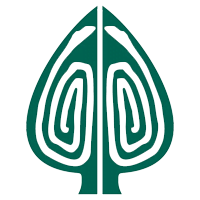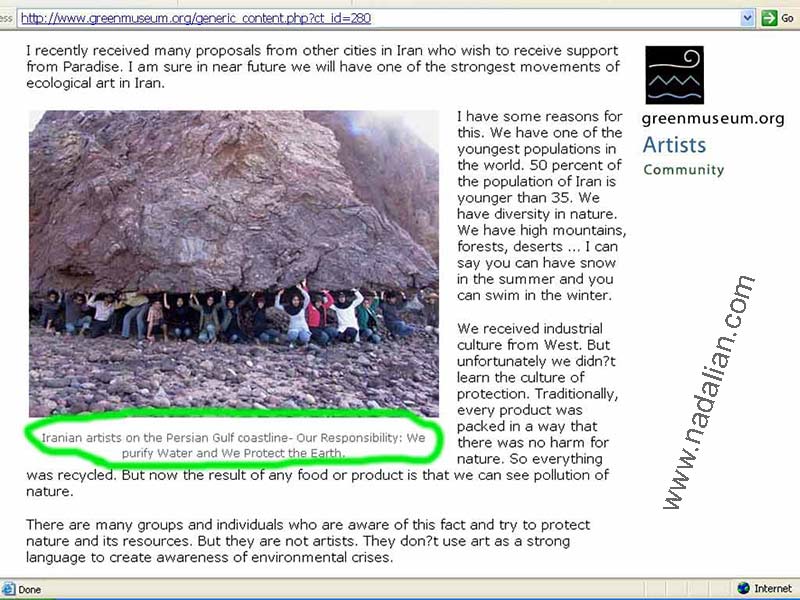After the report of the Persian Gulf Environmental Arts Festival was reflected on my personal website and its newsletter was sent to some thousand emails, I received an email from Mr. Sam Bower who wanted to use parts of my report for the Green Museum website in USA. He also makes an interview. In an email he sent to all his users, he introduced the Persian Gulf Environmental Arts Festival as a special event in January 2007.
He said:
” exciting events and opportunities, new art and a fascinating report from our artist friend Ahmad Nadalian in Iran. This promises to be an exciting year and we look forward to … “
Report: Environmental Art Festival on the Persian Gulf
by Ahmad Nadalian
[This report was compiled from an account written by Ahmad Nadalian and includes text from a recent email exchange between the artist and Sam Bower of greenmuseum.org.]
An environmental art festival was held recently (January 1-5, 2007) on the coast of Bandar Abbass, Hormoz and Shykh Andar Abi islands, in the Persian Gulf. More than thirty artists created a wide range of sand sculptures and environmental installations.
At first the main aim at Persian Gulf Environmental Art Festival was arranging a workshop for sand and stone sculptors. This was the initial suggestion of the Cultural office of Hormozgan, the Director of visual art center in Bandar Abbass. As a director of the workshop I changed the approach and now everybody is happy about the result and its extension. What began as a 3 day workshop is now planned to be an annual Winter event.
Supported by the Paradise International Art Center in Iran, this week (22 January) more than 25 artists from other cities in Iran will travel to the Persian Gulf and continue creating art in nature with local artists. On the 21 of March our national new year will start. We have two weeks of holiday. About two million Iranian people visit the Persian Gulf area. We plan to exhibit all visual documentations of this event during our national holiday and invite people to experience the beauty of Hormoz and environmental art.
Hormoz is 40 kilometers large and it has about 7 thousand inhabitants. But Sheykh Andar Abi, in particular is very small and tiny: 35 meters wide and 400 meters long. It has no inhabitants. There is only a small holy place (this is not a grave. Local people say it may have become sacred after a dream), a simple marker made of bricks and plaster in the center of the island.
We had a small budget (less than $800 US for the whole event) for the first three days, thanks to local organizations such as the Cultural office of Hormozgan. The city council members from Hormoz also kindly hosted artists at their homes.
These sorts of budgets are too much for small cities. They do not have enough funds to support cultural events. But is not the usual budget for an event in the capital city, Tehran. For example, an International sculpture symposium will be held in February by the city council in Tehran and plan to spend more than $700.000 US. The first prize for this symposium is $70.000 US. Seven artists will receive prizes.
The artists who participated in the Persian Gulf Environmental Art Festival are young and considering the budget for this event (less than $800 US for the whole event), the results were amazing.
In recent years there are some other festivals in which artists make sand or snow sculptures. In these events protection of nature is not very important. They are usually arranged by local government people to bring attention and tourists to that aria.
For the festival at first we needed to clean the environment. People make garbage, but we used the garbage found on the beach to make people. At the end the artists picked all garbage up and removed it from the area.
Participants at the Festival made numerous works using beach sand and rocks. Inspired by the example of ancient cylinder seals, I made a big cylinder seal and printed images of fish along the beach.
This cylinder seal was then left on the coast for the ocean to take away. It was dedicated to the unknown fish man who may discover it. Very soon I came back to notice that this gift had been accepted.
Hormoz is one of the most colorful islands in the world. God has painted this island. Artists also made several art works using colored earth from nearby mineral deposits. They are purely organic and there is no harm to the environment.
We used this to temporarily “paint” stones and make patterns on the beach. Unfortunately, a local company exports this valuable earth and uses it in some industry. Unfortunately, most of the people of Hormoz are poor and have no income and many receive charity from the government. We artists aim to introduce the value of this earth as an art material and we invite all artists across the globe to visit this beautiful island.
I also painted student’s faces and hands using local red earth “Gelak”. This red earth is used to cook “Soragh” which is a traditional food. It consists of organic earth, fish and a kind of lemon or sour orange. Usually Soragh is served with bread. Experience shows that the colored earth doesn’t affect the body, so we enjoyed using this earth as a medium for art. The most glorious moment was the performance where we used red earth “Soragh” to paint bread and then we all ate it together. We were the real earth artists: a link between earth, art and…
~~~~~~~~
~~~~~~~~
~~~~~~~~
INTERVIEW with Ahmad Nadalian:
~~~~~~~~
~~~~~~~~
I am environmentalist and am very interested in interactivity and new media. As an artist, my work is mainly inspired by the environment. New media plays an important role in sharing information about my work. Both the natural and social environment shapes what I do. I interact with local people or an audience when I work outdoors. I love interactive work and I dont like to dictate one type of narration to my audience.
I have always been interested in making bridges. Bridges between ancient symbols and new media. Bridges between folk art and intellectual art. I want to take intellectual art to the areas where ordinary people live. On the other hand, I am interested in bringing the existing values from the culture of folk art to the art centers where intellectual art is practiced.
I love to take an issue which is local and make it global. Today environmental crises can be seen in our villages and also in global village. The same can be said about bridges between Iranian and American environmentalists.
Despite all political disputes we can have discourse and think about the future of our planet. We live in two countries but on same earth and the same God created all nations.
One of my aims was to say that everything is not politics. CNN, BBC, Euro News always speak about politics in Iran. I would say there are also flowers, trees and people who love nature. I don’t have enough knowledge about the environment and art in other Middle Eastern countries. It seems that our two main neighbors (Iraq and Afghanistan) have for many years been involved in war and in this case the main goal can be saving humans. It is obvious that during the war nature was sacrificed.
My activity as a director of an environmental art center is not new. Since 1996, during the spring and summer I have lived with my family in Nature and focused on green art. Our first environmental art festival was held in the summer of 2003. More than 60 young artists participated in this festival, four of whom were international artists. One artist from the UK- Fergus Meiklejohn produced a documentary film about New Art in Iran called “After Paradise”. We had also a guest from Germany, Masoud Graf Hashempour, Raha Ra’isnia from the USA and Nasrin Tabatabaie from the Netherlands.
Since 2003 we have received more than 20 international artists and some hundreds of young artists have enjoyed Paradise’s little garden. For activities in the Paradise International Art Center so far we haven’t received any government funds or support. The accommodation is free for young Iranian artists. But international artists pay their own cost of trip etc.
I recently received many proposals from other cities in Iran who wish to receive support from Paradise. I am sure in near future we will have one of the strongest movements of ecological art in Iran.
I have some reasons for this. We have one of the youngest populations in the world. 50 percent of the population of Iran is younger than 35. We have diversity in nature. We have high mountains, forests, deserts … I can say you can have snow in the summer and you can swim in the winter.
We received industrial culture from West. But unfortunately we didn’t learn the culture of protection. Traditionally, every product was packed in a way that there was no harm for nature. So everything was recycled. But now the result of any food or product is that we can see pollution of nature.
There are many groups and individuals who are aware of this fact and try to protect nature and its resources. But they are not artists. They don’t use art as a strong language to create awareness of environmental crises.
I know a few artists who have worked inside cities or presented their works in galleries and their works can be classified as eco art. But most environmental artists in Iran who are very young are linked with Paradise.
The religious teachings from pre Islamic religions such as Zoroastrian, Manichaean, Mithraism and later Islamic religion in Iran also mention the protection of nature. This culture has been forgotten. We intent to revive past rituals which regard Nature as a manifestation of God.
Views: 2

 فارسی
فارسی

